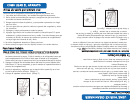
6
6
UUSSIINNGG YYOOUURR IICCEE CCRREEAAMM MMAAKKEERR
TToo MMaakkee IIccee CCrreeaamm::
14.Unplug and remove motor or hand crank once ice cream has churned for
about 40 minutes, or once the motor has stopped (if the motor has stopped
prematurely, turn it off, break up any ice blockages with the plastic
stirrer and start again).
15.With one hand on the canister lid to hold it in place (canister will have a ten-
dency to float up in the ice water mixture), remove the motor or hand crank.
Carefully lift the mixing canister from the wooden bucket.
16.Clear the ice and salt away from the top of the ice cream canister.
Wipe carefully to remove the salt and water before removing the cover.
17.Take the dasher out and scrape off excess ice cream with a spatula.
18.Transfer to a freezable container and freeze, or serve straight from
the canister.
HHeellppffuull HHiinnttss
• For each batch of ice cream, expect to use 7-14 lbs. of ice.
(1-2 medium size bags)
• Many ice cream recipes call for raw eggs. To eliminate salmonella
from your egg mixture, heat it to a temperature of 160°F, but do
not boil it. This will make the ice cream safe to eat. You may also
use pasteurized eggs in place of raw eggs.
• Be sure to chill mixture prior to adding to canister.
• To avoid ice cream seeping out of the canister, do not lay the
canister flat when storing in a freezer.
• For ice cream recipes that require pre-cooking, it is recommended
that you make the mixture a day ahead. The mixture will then be
able to cool completely and expand. Pre-chilling any ice cream
recipe is suggested for achieving the best results.
• Artificial sweeteners may be substituted for sugar. Use the
following proportions for reference:
1 packet of sweetener = 2 tsp. sugar
6 packets = 1/4 cup
8 packets = 1/3 cup
12 packets = 1/2 cup
• The churning process should take about 40 minutes.
CCOOMMOO UUSSAARR EELL AAPPAARRAATTOO
PPaarraa hhaacceerr hheellaaddoo
14. Desconecte y retire el motor una vez que el helado se haya batido durante
40 minutos aproximadamente o cuando el motor se detenga (si el motor se
detiene prematuramente, apáguelo, rompa cualquier obstrucción de hielo
que haya con el agitador de plástico e inicie de nuevo).
15. Con una mano sobre la tapadera del bote, retire el motor o la manivela
manu al de la cubeta de madera. Tenga cuidado - el bote suele flotar en la
mezcla de sal, hielo, y agua. Retire el bote de la cubeta de madera.
16. Quite el hielo y la sal de la parte superior del bote del helado. Limpie cuida
dosamente a fin de remover la sal y el agua antes de levantar la cubierta.
17. Saque la agitadora y con una espátula de madera y retírele el exceso de
hela do.
18. Pase el helado a un receipiente para congelar y congélelo o sírvalo directa
mente del bote (garrafa).
CCoonnsseejjooss UUttiieess
• Para las recetas de helados que requieren algo de cocimiento previo,
se recomienda que la mezcla se haga con un día de anticipación. Así
la mezcla podrá enfriarse y expandirse completamente. Se sugiere
enfriar previamente todas las mezclas de las recetas de helados, con el
fin de lograr los mejores resultados.
• El proceso de congelamiento se debe durar aproximadamente
40 minutos.
• Se usa aproximadamente 7-14 libras de hielo para cada bote del
hela do.
• El azúcar se puede substituir por edulcorantes artificiales. Utilice
las siguientes equivalencias como referencia:
1 sobrecito de edulcorante = 2 cucharas de azúcar
6 sobrecitos = 1⁄4 de taza
8 sobrecitos = 1/3 de taza
12 sobrecitos = 1/2 de taza
• Para evitar que el helado se escurra fuera del bote, no lo coloque ho
zontalmente cuando lo guarde en un congelador.
• No tape el agujero de drenaje a un lado de la cubeta de madera. Éste
es para drenar el exceso de agua salada y deberá mantenerse
abierto siempre.
• Asegúrese de que haya enfriado la mezcla antes de vaciarla en
el bote.
• Muchas recetas requieren huevos crudos. Para eliminar la bacteria
salmonelosis, caléntelos hasta una temperatura de 160°F, pero no
los ponga a hervir. Así se hace seguro comer la mezcla. También se
puede usar huevos pasterizados.


















